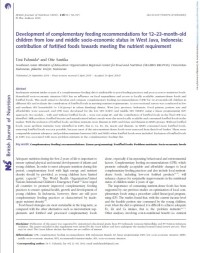Development of complementary feeding recommendations for 12-23-month-old children from low and middle socio-economic status in West Java, Indonesia: contribution of fortified foods towards meeting the nutrient requirement

Abstract
Inadequate nutrient intake as part of a complementary feeding diet is attributable to poor feeding practices and poor access to nutritious foods. Household socio-economic situation (SES) has an influence on food expenditure and access to locally available, nutrient-dense foods and fortified foods. This study aimed to develop and compare complementary feeding recommendations (CFR) for 12–23-month-old children in different SES and evaluate the contribution of fortified foods in meeting nutrient requirements. A cross-sectional survey was conducted in low and medium SES households (n 114/group) in urban Bandung district, West Java province, Indonesia. Food pattern, portion size and affordability were assessed, and CFR were developed for the low SES (LSES) and middle SES (MSES) using a linear programming (LP) approach; two models – with and without fortified foods – were run using LP, and the contribution of fortified foods in the final CFR was identified. Milk products, fortified biscuits and manufactured infant cereals were the most locally available and consumed fortified foods in the market. With the inclusion of fortified foods, problem nutrients were thiamin in LSES and folate and thiamin in MSES groups. Without fortified
foods, more problem nutrients were identified in LSES, that is, Ca, Fe, Zn, niacin and thiamin. As MSES consumed more fortified foods,
removing fortified foods was not possible, because most of the micronutrient-dense foods were removed from their food basket. There were
comparable nutrient adequacy and problem nutrients between LSES and MSES when fortified foods were included. Exclusion of fortified foods
in LSES was associated with more problem nutrients in the complementary feeding diet.
Detail Information
| Series Title | : | - |
| Call Number | : | - |
| Publisher | : | : B J Nutr., 2016 |
| Collation | : | Br J Nutr . 2016 Jul:116 Suppl 1:S8-S15 |
| Language | : | English |
| ISBN/ISSN | : | - |
| Classification | : | NONE |
 Computer Science, Information & General Works
Computer Science, Information & General Works  Philosophy & Psychology
Philosophy & Psychology  Religion
Religion  Social Sciences
Social Sciences  Language
Language  Pure Science
Pure Science  Applied Sciences
Applied Sciences  Art & Recreation
Art & Recreation  Literature
Literature  History & Geography
History & Geography